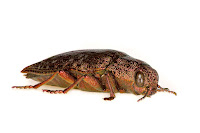This is the time of year when millions of people are reaching for firewood on a regular basis. For some of these people, wood is a necessity to keep warm and cook food, for others it is a source of comfort and coziness on a wintry day. In any case, firewood can harbor insects that no one wants inside their dwellings.
 |
| Carpenter Ants |
There are two basic types of insects that dwell in firewood - those that burrow into and feed on wood (beetles and borers) and those that use the firewood as shelter (sometimes short term, sometimes overwintering). Any type of insect popping out of your wood can be an unpleasant surprise, but neither of these types pose any real threat to your home. Carpenter ants and termites, on the other hand, can be found in firewood and they have the potential to infest a home. Keeping those two damaging pests at bay begins with the proper storage of firewood – up and off the ground. Wood placed directly on the ground makes it simple for termites to annex your woodpile as an addition to their underground lairs. These insects can also use a woodpile stacked against the house to gain access to the structure, so don’t do that either.
 |
| Metallic Wood-Boring Beetle |
There are many species of insects that infest wood like
metallic wood-boring beetles,
powderpost beetles (aka shothole borers),
bark beetles and
roundheaded wood borers |
| Horntail Wasp |
(aka longhorned beetles). However, there are some wasps (
horntail or wood wasps) that attack wood as well. These types of insects will have been in the wood before it was cut into logs. If you are doing the cutting, you will no doubt see the damage caused to the wood or the insects themselves. If you use commercially cut wood, and most of us do, you should be aware of what to look for. These types of insects feed on and bore into wood throughout their lifespan, which can be a couple of years. If you don’t see the actual insects, you will see the tunnels and other damage they make. For instance, you’ll know you have powderpost beetles by the small piles of sawdust dripping from small holes. There are also wasps that go for dead and dying wood – horntail wasps (aka wood wasps). Generally speaking, these types of insects prefer a moist wood, so you should allow your firewood the dry out thoroughly before bringing it in.
 |
| Bark Louse |
There are a lot of different kinds of beetles that make their homes inside firewood, but there are even more creatures that use the woodpile for shelter. These include
sowbugs, wood cockroaches, mice, scorpions, spiders, millipedes and centipedes and
bark lice. All of these can inadvertently be brought into your house and most pose very little threat to people. The problem is that you don’t want any of them popping out of a woodpile and joining you for a cozy night around the fire. The best way to avoid this is to give the logs a visual once-over to check for webbing or cocoons. After that, shake or knock the logs together to dislodge anything hiding.
 |
| Emerald Ash Borer |
 |
| Asian Longhorned Beetle |
There are two invasive pests that can be found in firewood that you should be on the lookout for. These are the Asian longhorned beetle and the emerald ash borer. These pests are threatening our native trees and need to be contained. Take a minute to familiarize yourself with these pests so that you will recognize them. If you find any, take the proper steps.
This article gives guidance on the Asian longhorned beetle and
this one addresses the emerald ash borer. Only buying local firewood (within 50 miles) and not transporting firewood are two easy steps you can take to stop the spread.
 |
| Baby Mantids & Their Ootheca |
A word about praying mantids: Over this past Christmas season, there was a lot of chatter about mantid egg cases on Christmas trees. Such a thing is clearly possible, but unlikely. The same can be said for firewood. Praying mantids place their egg cases on trees and bushes, and while they appear quite sturdy, they are not invincible and can be dislodged or damaged by transport. These are some things I’ve learned here at ARBICO from purchasing tens of thousands of wild-gathered
mantid oothecas each year. If you do come across an egg case, you should put it outside or in a jar with teeny-tiny holes in it. When it hatches you'll have dozens of baby mantids running amok.
At this point, you may be considering spraying your firewood with insecticide to avoid any unwanted visitors. But this is an absolute “NO”. Firstly, most insecticides will not penetrate the wood deeply enough to actually be effective. Secondly, insecticides can emit highly toxic fumes that are especially intense when burned. So, just don’t do it.

I have given you some actions to take to reduce the likelihood of pests in your firewood, but
this article gives more detailed directions. And their recommendations are easy to do.
Take Care
Submitted by Pam
















No comments:
Post a Comment